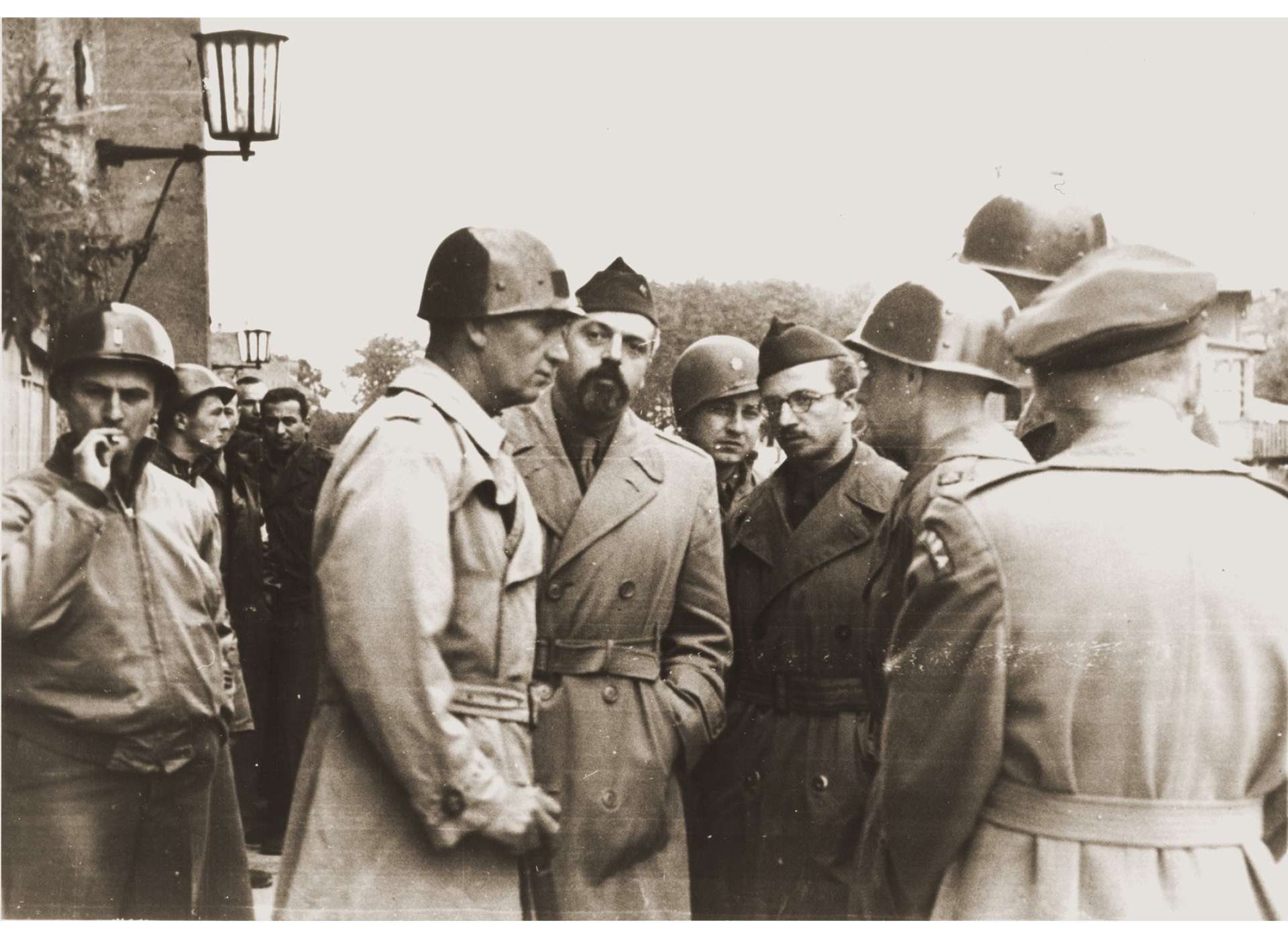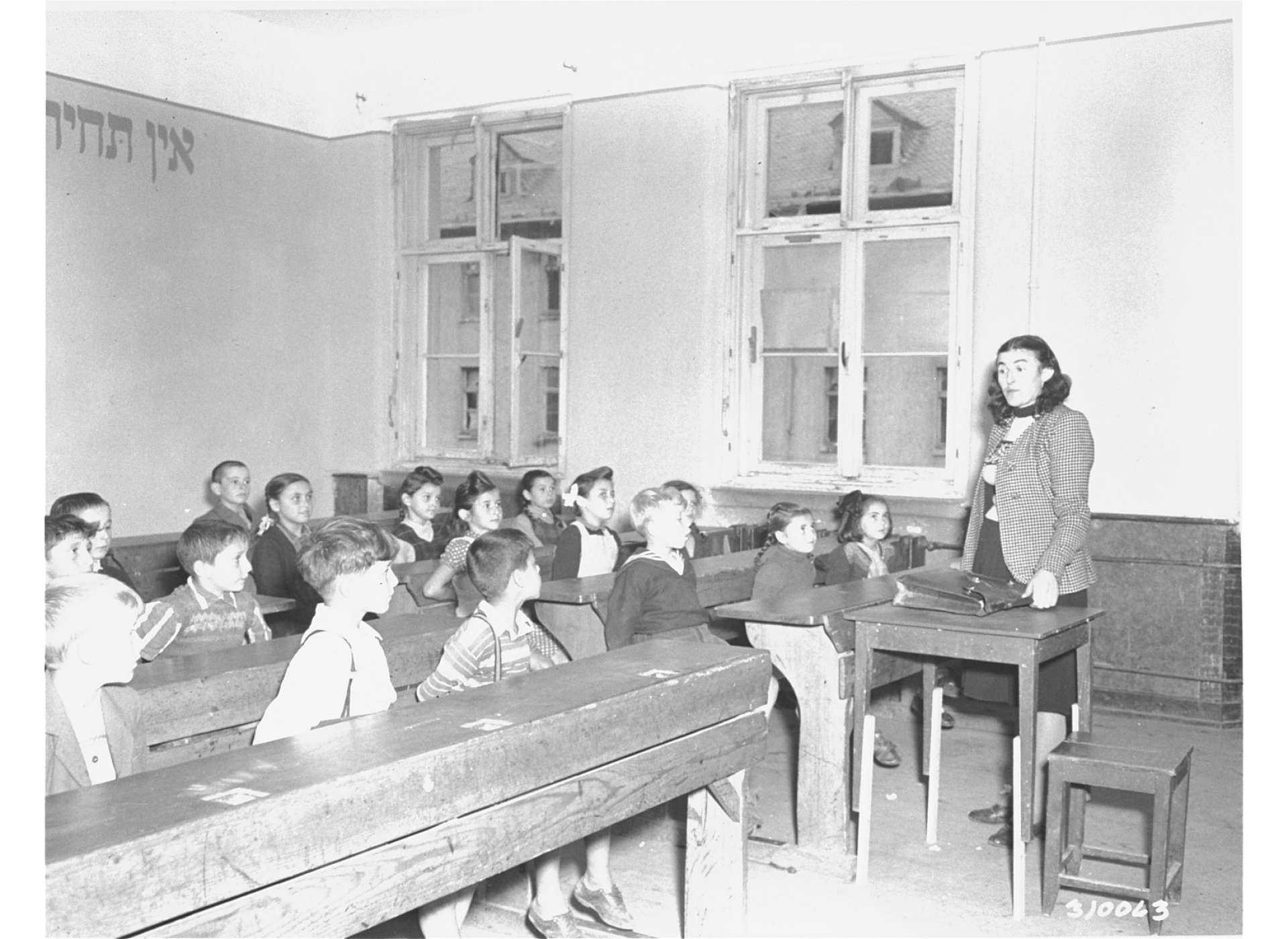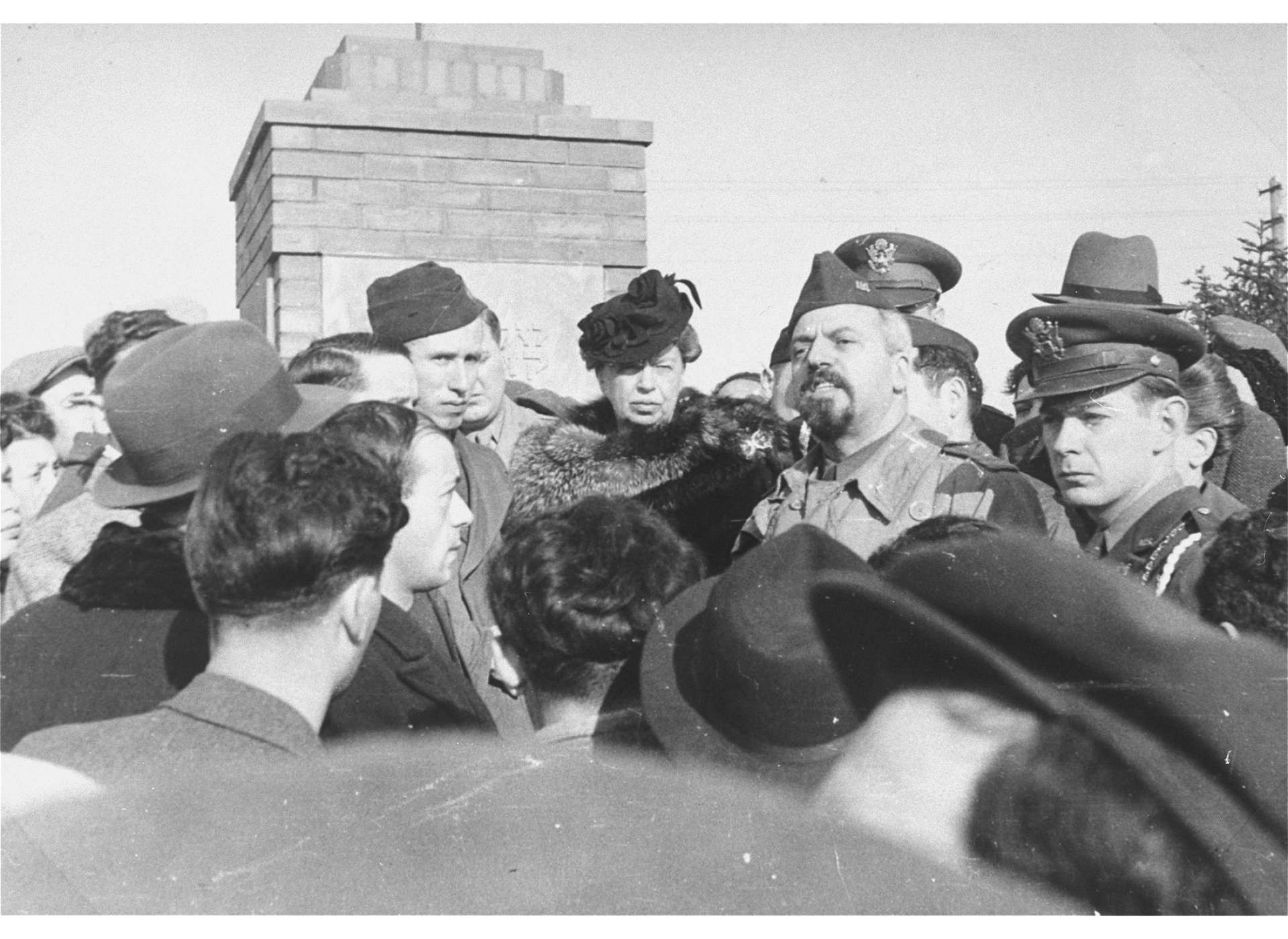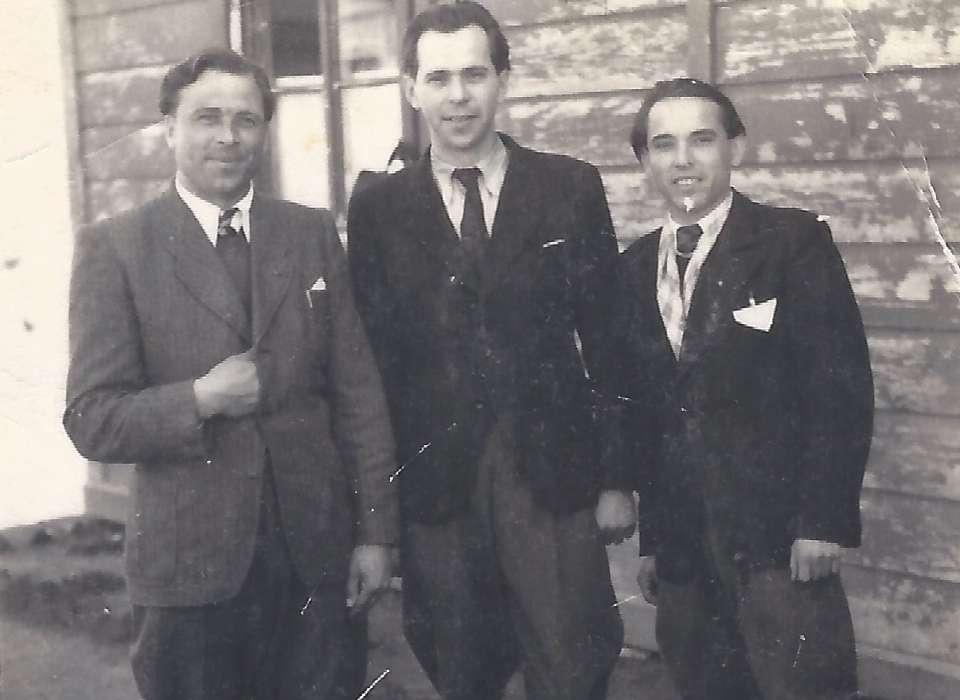Top image: Ukrainian DPs in Camp Barracks in Germany, photo is property of the author.
“When this ghastly war ends,” Franklin D. Roosevelt predicted in October 1939, “there may be not one million but ten million or twenty million men, women, and children… who will enter into the wide picture—the problem of the human refugee.” Eleanor Roosevelt echoed her husband’s forecast six years later, when she personally became involved in aiding the postwar refugee crisis. “A new type of political refugee is appearing,” she observed in January 1946, “people who have been against [their] present governments and if they stay at home or go home will probably be killed.”
World War II uprooted and dislocated an unprecedented number of people—some 55 million in Europe alone. When the war ended there were approximately 11 million displaced persons (DPs) in Europe, eight million of which were located in Germany. They included about six million civilian volunteer and forced laborers [LINK Nazi Forced Labor Policy in Eastern Europe article], two million prisoners of war, and 700,000 surviving concentration camp prisoners. Additionally, thousands of anticommunists and former Nazi collaborators from Czechoslovakia, Hungary, Poland, the Soviet Union, and Yugoslavia fled the Red Army as it reconquered Eastern Europe.
Between May and September 1945, most displaced persons willingly returned home, with Allied military personnel overseeing the departure of an estimated 33,000 DPs per day. Others were forcibly repatriated at the hands of Soviet authorities. By the end of September, however, 1.2 million displaced persons remained in Germany and refused to return home. Most of them were concentrated in the Western occupation zones, especially in the southwestern regions under US control.
By 1951, the majority of these displaced persons, often referred to as “the last million,” had immigrated to the United States, Canada, Australia and other parts of the world. Their refusal to return home, however, caused international debate concerning the status of refugees. It also had an impact on the development of international refugee protection and led to the first comprehensive definition of a refugee.
The Postwar Refugee Problem
Before the war ended, Roosevelt, Churchill, and Stalin met at Yalta in February 1945 to discuss the postwar organization of Europe. At Yalta, the United States and the Soviet Union arranged for the immediate repatriation of civilians and prisoners of war. The agreement specifically stated that citizens of each country, “will without delay after their liberation, be separated from enemy prisoners of war and will be maintained separately from them in camps or points of concentration until they have been handed over to the Soviet or United States authorities.”
A subsequent agreement signed by the United States, Britain, and the Soviet Union in Halle, Germany on May 23, 1945, reinforced each country’s commitment to the repatriation of all civilians and prisoners of war. It also designated exchange points, regulated the number of persons to be processed daily, and established the repatriation of Allied citizens as a postwar priority.
The summer of 1945 represented the height of postwar repatriation and, by the beginning of July 1945, 1.5 million Soviet citizens had been returned to the Soviet Union. The Supreme Headquarters Allied Expeditionary Force (SHAEF) and the United Nations Relief and Rehabilitation Administration (UNRRA), created in November 1943 as the first international organization designed to deal with World War II DPs, assisted in the return of Eastern Europeans in the Western Zones of occupation.

“American military officers meet with officials from UNRRA and the Joint Distribution Committee in the Landsberg displaced persons camp,” George Kadish and Zvi Kadushin, October 1945, Landsberg Germany, United States Holocaust Memorial Museum, courtesy of Irving Heymont, Photograph Number: 31963.
Generally speaking, the UNRRA oversaw the establishment of temporary displaced persons camps and categorized DPs by citizenship while SHAEF assisted in relocating DPs to reception centers and organizing transportation home, but responsibilities sometimes overlapped. By the end of September 1945, SHAEF had delivered 2,034,000 Soviet citizens from the western zones of Germany, Austria, and Czechoslovakia and 230,000 from France, Norway, and other Western European countries.
The vast majority of displaced persons returned home willingly, but “the last million” saw repatriation as equivalent to deportation and insisted on remaining stateless. Their refusal to return home was fueled by a combination of political, economic, and psychological factors. Some of these included opposition to the expansion of Soviet influence in Eastern Europe, resistance to communist economic and political systems, and desire for religious freedom. Many also feared punishment for suspected collaboration with Nazi Germany, since Stalin viewed anyone who assisted Germany during the war, including forced laborers, as traitors.
Forced Repatriation
In March 1946, ten months after the war ended, there were an estimated 400,000 Poles and roughly 150,00 to 200,000 Estonians, Latvians, and Lithuanians living in displaced persons camps in Germany. There were also between 200,000 and 225,000 ethnic Ukrainians, composed of Western Ukrainians who lived under Polish rule until September 1939 and of Eastern Ukrainians who held Soviet citizenship when World War II broke out.
In early 1946, Jewish refugees represented less than 10 percent of the overall DP population. As Gerard Daniel Cohen points out, however, a substantial number of “Jewish ‘infiltrees’ of Polish origin” gradually migrated to occupied Germany during 1947 and 1948, adding an additional 250,000 refugees to the American occupation zone. About 25 percent of them lived in Berlin and Munich outside the confines of official displaced person camps.

“A classroom at the Jewish displaced persons camp in Wetzlar,” Hugh Palmer, September 9, 1948, Wetzlar Germany, United States Holocaust Memorial Museum, courtesy of National Archives and Records Administration, College Park, Photograph Number: 82918.
Moscow wanted all Eastern European DPs to return home, whether they held Soviet citizenship or were from countries now incorporated within the Soviet sphere of influence. This was partially because the USSR suffered disproportionate losses during the war, which created a labor shortage and a war-torn economy. Stalin also feared that DPs remaining abroad posed a threat to the credibility of Soviet propaganda, which portrayed the Soviet Union as the world’s first successful communist state.
One of the major problems of the agreements signed at Yalta and Halle was that neither provided an explicit definition of “Soviet citizen.” The postwar incorporation of previously held Polish territories east of the Curzon Line into the Soviet Union complicated the matter, since Moscow believed anyone living in those regions were considered Soviet citizens, not Polish.
In the summer of 1945, the United States and Britain agreed that “Soviet citizens” were those who had resided in the Soviet Union at the outbreak of war on September, 1, 1939. Thus, Ukrainians living in prewar Poland before the war were to retain their Polish citizenship if they wished, but had to move within the new, postwar Polish borders. Similarly, Estonians, Latvians, and Lithuanians were also considered exempt from involuntary repatriation since the United States and Britain did not recognize the 1940 annexation of their homelands and, therefore, did not classify them as Soviet citizens.
UNRRA personnel, however, were often confused about how to classify Eastern Europeans in terms of citizenship given the shifting of borders and the multiplicity of place names. More importantly, Soviet repatriation officers frequently refused to abide by the citizenship criteria outlined by the United States and Britain and insisted that all peoples who had resided within the new borders of the Soviet Union before the war were now Soviet citizens and subject to repatriation to the USSR.
The Soviet Administration of the Plenipotentiary for Repatriation Affairs (APRA) was the official organization tasked with returning all Soviet DPs. The Foreign Mission of the APRA operated in 23 countries, using legal and illegal methods to repatriate displaced persons from Western-controlled areas. To encourage Eastern Europeans to return home, the APRA distributed pamphlets and newspapers, showed films, and gave speeches promising better living conditions under communism. In more extreme cases, the APRA collaborated with NKVD and SMERSH agents stationed in Germany to find Soviet citizens or intimidated and threated those resisting repatriation.
The agreements signed at Yalta and Halle did not explicitly address the use of force in repatriation efforts but permitted “all practicable means to ensure the evacuation of these liberated citizens.” The refusal of “the last million” to return home, however, increasingly led to violent clashes and forceful repatriation. The APRA, with Western Allied permission, had free access to displaced persons camps in the western occupation zones and often went through local worker registration documents, detaining those with Slavic names regardless of citizenship status. In the most extreme cases, Soviet repatriation officers rounded up and kidnapped at gunpoint those refusing to return home.
Wishing to placate the Soviet Union in order to ensure the safe return of their own POWs and believing that all displaced persons wanted to return home, the Western Allies initially complied with all Soviet repatriation methods, including forced repatriation. On July 8, 1945, SHAEF ordered that “citizens of the USSR identified as such by Soviet repatriation officers” be sent home immediately. Training packets distributed to all US troops stationed in Germany during the 1945-1946 occupation also instructed that “individuals identified by Soviet repatriation representatives as Soviet citizens are subject to repatriation without regard to their personal wishes.”
While it is hard to know with any certainty how many instances of violent forced repatriation occurred, there was enough documented resistance to cause Truman to ban the use of force in the US zone of occupation in October 1945. Subsequently, on December 21, 1945, the American State-War-Navy-Coordinating Committee prohibited forceful repatriation unless displaced persons were either captured in German uniform, were members of the Soviet armed forces after June 22, 1941, and not later discharged, or the Soviet Union could prove they had voluntarily aided the enemy.
These new orders did not deter Soviet repatriation officials. Instead, the APRA increasingly claimed that anyone detained by Soviet repatriation officers were war criminals or had voluntarily aided Nazi Germany. Although the new protocols drastically limited large-scale forced repatriation operations by the summer of 1946 in the US, British, and French zones of occupation, the APRA continued to arrest and ship Eastern European DPs home, regardless of their wishes until mid-1947.
Refugee Status
DPs resorted to a variety of methods to resist repatriation including organizing their own camps, establishing welfare committees, and working with organizations in the United States, Canada, and Britain. However, the most common method of resistance was to claim refugee status. Initially, this proved to be very difficult as there was no international organization designed to deal with refugees or an internationally recognized definition outlining criteria for refugee status.
Prior to 1944, refugees were considered to be a byproduct of repression or war and were only of interest to the international community in terms of humanitarian considerations. After WWI, the League of Nations did not contain any provision in its Covenant that rendered international aid or protection to refugees. Instead, it addressed the needs of refugees on a case-by-case basis.
For instance, it appointed a High Commissioner for Russian Refugees in 1919 to assist those displaced as a result of the Russian Revolution. Although this was not a permanent position, the Commissioner’s mandate subsequently expanded to cover other specific groups such as refugees from the Greek-Turkish War, the Spanish Civil War, and refugees fleeing interwar Nazi Germany.
In August 1938, the League established the Intergovernmental Committee on Refugees (IGCR) after a new initiative launched by President Roosevelt to consider the problem of racial, religious, and political refugees from central Europe. The IGCR’s main purpose was to assist in the resettlement of refugees from Europe in countries allowing permanent immigration. These efforts were only marginal successful, however, since by 1938 the League of Nations had become a powerless institution. Consequently, the IGCR had little impact on addressing the growing needs of refugees during World War II. It was not until the UNRRA assumed responsibility for refugees that the issue was adequately and seriously addressed.

“Eleanor Roosevelt visits the Zeilsheim displaced persons' camp,” E.M. Robinson, 1945-1948, Zeilsheim Germany, United States Holocaust Memorial Museum, courtesy of Alice Lev, Photograph Number: 89680.
To claim refugee states, Eastern European DPs petitioned UNRRA officers explaining the political and economic realities they would face if they returned home. These appeals emphasized Soviet atrocities, including bans on practicing religion and the destruction of churches under communism, mass starvation during forced collectivization, mass murder during Stalin’s purges in the 1930s, and rumors (which later proved to be accurate) of decade-long sentences for those who had been forced to work for Nazi Germany during the war. In cooperation with relief agencies in the United States and Canada, Eastern European DPs also sent letters to the US State Department, members of Congress, Eleanor Roosevelt, then a US delegate to the UN, and President Truman.
The main problem Western authorities faced was that it was difficult to conclusively determine citizenship since many displaced persons destroyed their IDs or provided false identification papers to avoid forced repatriation. To complicate matters, many UNRRA officials did not understand the political and economic realities facings displaced persons from Eastern Europe. This was particularly true for Ukrainians who held Polish citizenship prior to the war but whose homelands were annexed by the Soviet Union.
As the “last million” continued to refuse repatriation, it became clear that the UNRRA was not capable of dealing with the problem, both financially and in terms of personnel. The need for assistance from the United Nations was already being discussed at the Potsdam Conference, but no action was taken at the time. At an informal meeting in New York in September 1945, the British, French, and US delegates to the UN agreed that a new international agency was needed to deal with the remaining refugees.
Although Soviet delegates to the UN objected, the UN discussed the issue at the Third Committee of the UN Assembly, which met in London between January 10 and February 14, 1946. During these sessions, there was substantial disagreement as to the definition of “refugee,” particularly the freedom of choice for an individual to decide his or her own future and international responsibility for those refugees who resisted repatriation. The divergence of views on the matter was one of the first public confrontations between the Soviet Union and the Western Allies.
Nonetheless, the Third Committee took important steps towards the recognition of refugee status for many of those refusing to return home stating:
“No refugees or displaced persons who have finally and definitively, in complete freedom and after receiving full knowledge of the facts, including adequate information from the Governments of their countries of origin, express valid objections to returning to their countries of origin…shall be compelled to return to their countries of origin.”
The Third Committee also maintained that anyone who was unable or unwilling to return home due to events following the outbreak of World War II would receive international protection. This resolution expanded the definition of refugee and, for the first time, included “persecution or fear of persecution because of race, religion, nationality, or political opinion.” Although the UN did not come out and say that opposition to the Soviet government was grounds for refugee status, the new definition was broad enough to allow for this particular case of political dissent.
The 1951 United Nations Convention Relating to the Status of Refugees
Due to the postwar chaos surrounding who qualified as a refugee, the United Nations held a convention in 1951, during which it set forth international protocol on how to deal with refugees. As part of this process, the UN created a comprehensive definition of refugee, codified the rights of refugees on an international level, and consolidated previous international organizations dealing with the humanitarian aspects of refugee relief.
In contrast to earlier definitions of refugees, which only applied to limited and specific groups, the 1951 convention expanded the criteria to include a wide range of persecuted groups. According to Article 1 of the UN’s 1951 Convention Relating to the Status of Refugees, a refugee is:
“someone who is unable or unwilling to return to their country of origin owing to a well-founded fear of being persecuted for reasons of race, religion, nationality, membership of a particular social group, or political opinion.”
Thus, in 1951 the United Nations “legitimized each individual’s right of asylum and assistance based on persecution, or fear of persecution, regardless of former citizenship, race, or religion.” This laid the foundation for the current definition of “refugee,” which the UN adopted in 1967.
In the last years of World War II, Allied leaders, for the first time, addressed the question of displaced people within the context of larger discussions on the postwar peace settlement. This was partially due to the size of the refugee population, which affected economic and political reconstruction. It was also the result of a need for an agreement to conduct military operations for population exchanges at the end of hostilities. According to Maria Dyczok, “once the issues were raised at such a high political level it became difficult to disassociate them from questions of borders and the peace settlement.”
The postwar changes to borders and the establishment of Soviet-backed governments in Czechoslovakia, Hungary, Poland, and Yugoslavia is one of the reasons that Eastern Europeans refused repatriation. Many argued that their home countries would no longer be able to grant them basic human rights. By rejecting the policies outlined by the wartime Allies at Yalta and Halle, the actions of Eastern European DPs contributed to a revision of refugee policies by the Western Allies, international relief organizations, and the United Nations.
Jennifer Popowycz, PhD
Jennifer Popowycz, PhD is the Leventhal Research Fellow at The National WWII Museum. Her research focuses on the Eastern Front and Nazi occupation policies in Eastern Europe in World War II.
Cite this article:
MLA Citation:
APA Citation:
Chicago Style Citation:





![Max Fuchs, New York City cantor, sings as Rabbi Sydney [sic] Lefkowitz, Richmond, VA, conducts the first Jewish services from Germany.](/sites/default/files/styles/max_650x650/public/2025-10/image1.jpg)



